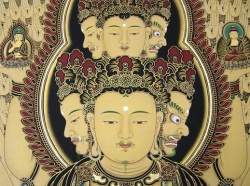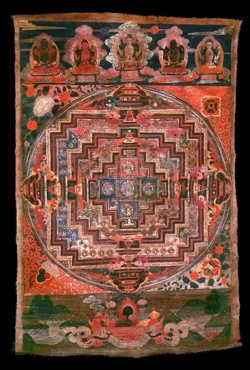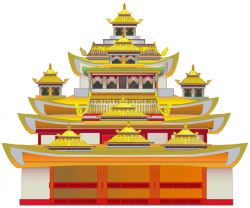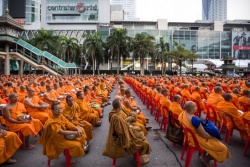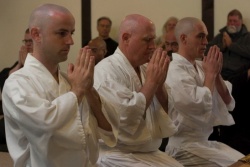Creating Sangha
A Buddhist community - a Sangha - is not something one is merely born into or chooses to join, but something one is challenged to create.
A Sangha provides a matrix of communal support for people to realize their commitment to a common vision or concern.
Yet it is in danger of lapsing into an institution intent on preserving the power of a minority of professionals.
A Sangha requires some kind of organized structure to serve an effective purpose within a given society and persist over generations. The Sangha-structures in Buddhism over the past 2,500 years have for the most part been monastic communities.
Few would disagree that monasticism, with its vows and disciplines, provides the time and freedom to reflect on the Dharma and a conducive framework for cultivation of concentration and insight.
For this reason, since the time of the Buddha, the survival of the Dharma has been seen as dependent upon the survival of a monastic community.
In most Asian countries, the very term "community" (Sangha) has come to refer to the monastic community alone.
While a sympathetic laity is required to support the monks and nuns, the lay people?s limited opportunity for realizing the scholarly and contemplative goals of Buddhist practice has led to their assuming an inferior status to monastics.
We find ourselves in a very different kind of society to those that prevailed in Buddhist Asia.
What kind of role might a monk or nun play in this world?
A monk or nun acts as a visible challenge to the shallow, distracted lives in which many people find themselves trapped.
By their very presence monastics assert values that are either ignored, denied or simply forgetten.
Monastics are a reminder of that part of our lives that may be dimly recalled but is usually neglected.
Irrespective of one?s opinions about monasticism, to encounter a monk or nun in the flesh can have a powerful impact: for the faithful they act as a concrete affirmation of their values; for the sceptics a challenge to pre-occupations with what is fleeting and self-centred.
Monastics are living symbols who point beyond their own personality to something that is always present, even though awareness of it may be suppressed.
Prince Siddhartha himself was motivated in his quest for awakening upon encountering four sights: one of them, a wandering monk.
The encounter with the monk is put on the same level as those with the sick person, the old person and the corpse.
Just as the meeting with the concrete realities of sickness, ageing and death opened his eyes to his own existential dilemma, so the sight of the monk opened his eyes to the possibility of a response to this dilemma.
It was not necessary for the monk to say anything: his mere presence as a homeless renunciate was sufficient to force upon the prince the awareness of the values he had neglected in his life of sensory indulgence.
Here lies the meaning of monasticism as a form of life standing in a polar relation to secular society.
The issue of monasticism today does not concern its validity as an exemplary way of life in which to practice the Dharma.
It concerns its relationship to the Sangha, the Buddhist community, as a whole.
Should communities of monks and nuns still be considered as the core of the Buddhist Sangha?
Or does the present situation call for a definition of Sangha in which the role of monastics is less central?
As Buddhism developed over centuries in different cultures, its form was determined by the economic and social conditions of former times. All traditional forms of Buddhism share in common the stamp of a medieval social structure.
They emerged in societies with fixed class distinctions in which the course of a person?s life was determined at the time of his or her birth.
The division between monastics and laity was as sharply defined as the division between classes.
The life of the majority of the laity consisted of agricultural labor and the raising of families.
A formal education was very limited if not absent.
Monastics, in contrast, were largely free from having to engage in manual labor and had no family responsibilities.
They were able to devote themselves entirely to the Dharma: through the study of philosophy, the practice of meditation and by serving a pastoral role in the community.
As a consequence of this split, the practice of Buddhism assumed two distinct forms.
The laity, with neither time nor education, engaged primarily in prayer and devotional practices aimed at improvements in a future life.
In addition, they provided material support to the monastic communities as a means of accruing merit and maintaining the institutions that concretized their religious beliefs.
The monastics? practice was entirely different.
As a result, they developed sophisticated philosophies as well as a precise and detailed understanding of spiritual practice.
Of course, occasional lay people sometimes attained comparable heights.
But the very fact that so much attention is given to the lay status of such figures as Vimalakirti and Marpa, only illustrates how they were clearly the exceptions rather than the rule.
Quite understandably, the Buddhist community - the Sangha - was identified with the monastic community.
For given the nature of Buddhism, with its emphasis on prolonged practice aimed at awakening, together with the economic and social constraints on the laity, it could not easily have been otherwise.
In former times, the vast majority of the laity lacked the possibility to actualise within their own lives the experience of awakening that is vital to the continuity of the Buddhist tradition.
The question today is this: is the modern world sufficiently different to require such a radical departure from tradition that monasticism would no longer be considered central to the Buddhist Sangha?
Nowadays, the condition of the laity, even in traditional Asian Buddhist countries, is being transformed.
No longer is the intellectual or moral superiority of monastics taken for granted.
The nature of both inter-personal and social relationships has undergone vast changes too.
Education is no longer the privilege of minority groups such as the aristocracy and monastics. Intellectual inquiry and philosophical thinking are possible for whoever is inspired to undertake them.
State education and the development of tele-communications provide the basis for an active and critical spiritual life for a growing number of people.
Leisure time in which to pursue such matters is also no longer the privilege of minority groups. Moreover, these pursuits can no longer be considered primarily the affair of men.
In accordance with the central Buddhist doctrine of "conditionality," the concept of Sangha and the role of the monastic in Buddhist societies arose in dependence upon the socio-economic conditions of former times.
And in accordance with the equally central notion of "impermanence," they too are subject to change.
There is, nonetheless, a trend to overlook the implications of these doctrines on Buddhism itself and its institutions.
This may in part be due to the one-sided interpretation of impermanence as "subject to destruction." This negative connotation obscures how it is equally a pre-condition for creation, transformation and renewal.
Change is neither good nor bad: it is simply the way things are.
It would not be unreasonable to conclude that the traditional concept of Sangha may no longer be relevant today.
It would seem self-evident that for the Buddhist community to survive, it must adapt itself to the changing world.
To insist upon preserving traditional institutions irrespective of circumstances would be to indulge in a dinosaur mentality.
The question of survival depends essentially on the structure of the Sangha; for the Sangha is the communal expression of the Buddhist experience that needs to be rooted in the soil of society as a whole.
As such it draws its sustenance from beyond its own immediate boundaries; but if its root-structure demands a soil that no longer exists, it will inevitably wither and die.
But it is still maintained by traditional Buddhists that communities of monastics are solely responsible for the continuation of the Dharma. While it is true that the Sangha is essential to the survival of Buddhism,
is it justified to assume such an identity between the Sangha and the monastic community?
For it may well be an identity formed by socio-economic rather than spiritual needs.
While it is true that most of what we know of Buddhism today was preserved and handed down by monastics, it is also true that its present moribund condition in Asia is due to having embodied its communal center in monastic institutions.
While tradition claims that monastics are the greatest strength of the Buddhist community, history suggests they are one of its greatest weaknesses.
Why was Buddhism unable to survive the Moslem invasion of India during the twelfth century, whereas Hinduism, which suffered equal persecution, was?
One major factor was that Buddhism relied for its continuity and identity upon isolated monastic groups.
To destroy Buddhism it was only necessary for the Moslems to destroy the monasteries. With the monasteries gone, the lay community swiftly disintegrated because of the lack of a cohesive center.
Hinduism, on the other hand, was far more integrated into the fabric of Indian society - and therefore much more difficult to destroy.
In Tibet too the rapid destruction of Buddhism can likewise be blamed partially upon the monasteries.
Here Buddhism was more socially integrated and had assumed political as well as spiritual authority.
But it was the monks? insistence upon preserving the rigid forms of their institutions and their pursuing an isolationist policy that left Tibet defenseless against outside interference.
The transcendental aims of the monks were translated into a political apparatus, making not only the monasteries but the entire structure of society vulnerable to secular ambitions.
Likewise in China, Mongolia, Vietnam, Laos and Cambodia, Buddhism was undermined through destroying the monastic framework upon which the community depended.
Indeed it is remarkable to compare the extent of the Buddhist world fifty years ago with what remains today. Never in human history has such a major world religion diminished in size and influence so rapidly.
Three or four revolutions in the right places would more or less eliminate traditional Buddhism from the face of the earth.
This is not to suggest that monastics are redundant or unimportant, but that their role in the Buddhist community might need to be re-evaluated.
If Buddhism is to survive, it needs to find a firm communal footing within the framework of secular culture.
Insistence on monasticism as central to the survival of Buddhism could result in hastening its downfall, rather than ensuring its preservation.
While the Dharma certainly needs to be embodied in a distinctive Sangha, it may no longer be necessary for this Sangha to be identified primarily with monastic institutions.
The emergence of those outside the monastic fold who are pursuing an intelligent and serious practice of the Dharma is creating the communal matrix for a new conception of Sangha.
It is in such a setting that Buddhists are being challenged to maintain the rigour and depth of their traditions while at the same time to function both caringly and critically in a modern society.
Today one finds oneself adopting a practice of Buddhism that exceeds in depth and diversity the traditional lay practice of prayer and devotion.
One?s knowledge and experience of Buddhism may not always equal the depth of insight made possible through a monastic life of a single-pointed contemplation,
but this lack needs to be seen in the light of an enhanced ability to apply the Buddhist teachings under a wider and more complex range of conditions.
We find ourselves in a situation with an increased freedom to practice yet without being constrained in our social interactions by monastic vows. Here, it seems, we discover the seeds of a new conception of Sangha.
Yet rather than theorizing about the nature of such a Sangha, we need to act.
The challenge is to imagine and then create a communal structure that works in practice.
As with all good experimentation, we need to proceed with an open mind free from attachment to the outcome.
We must be ready to learn from whatever historical alternative models already exist: from the non-celibate yogic tradition of the Tibetan Nyingma school to the Japanese system of hereditary priests.
We also need to learn from history?s mistakes and work to create a Sangha that is no longer ridden with the sectarianism, dogmatism, authoritarianism and sexism endemic to many Asian traditions.
For the creation of a viable Sangha is the single most important challenge facing Buddhists throughout the world today.
Without it, the Dharma is liable to become either the preserve of benign eccentrics on the margins of the world or gradually absorbed into other disciplines and lose its identity altogether.
Despite its failings, the monastic Sangha has successfully weathered more than two and a half millenia of upheaval and change.
Will the alternative we put in its place prove so effective and enduring?
That will be the test. We need to be on guard against the giddy hubris of modern secularism that dismisses such a resilient institution as atavistic and irrelevant.
Ultimately, whatever kind of Sangha emerges in the West, it will do so out of a continuum of practice sustained over generations. In a way that no one can predict.
This is a variation on an essay entitled MONKS, LAITY AND SANGHA, which appeared in the Middle Way (Vol.58, no.1) in 1983, written while the author was a monk.
This version appeared in Tricycle. Vol 5, no. 2. New York: Winter 1995.
Source
http://www.stephenbatchelor.org/index.php/en/creating-sangha
